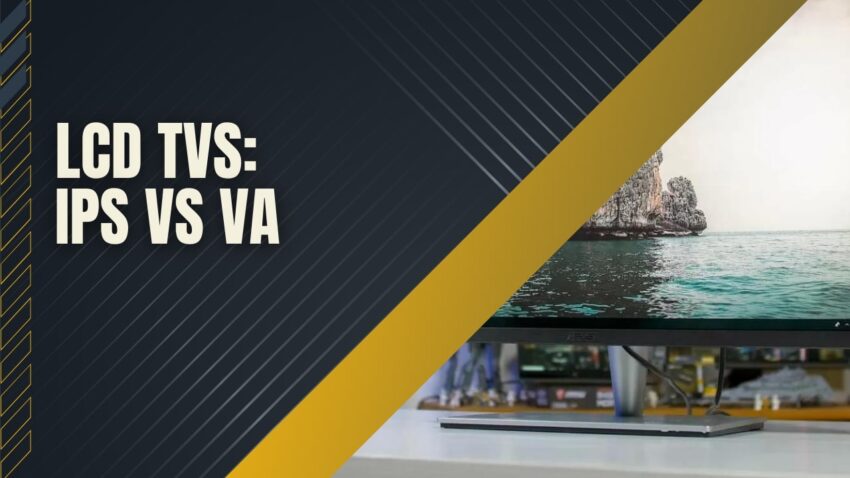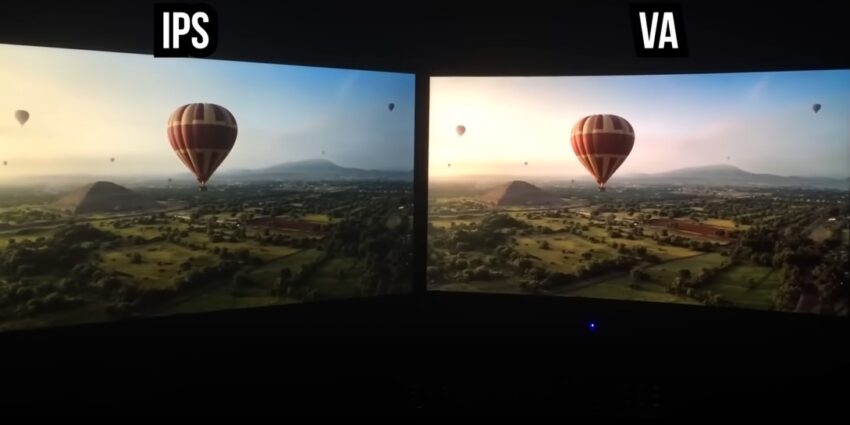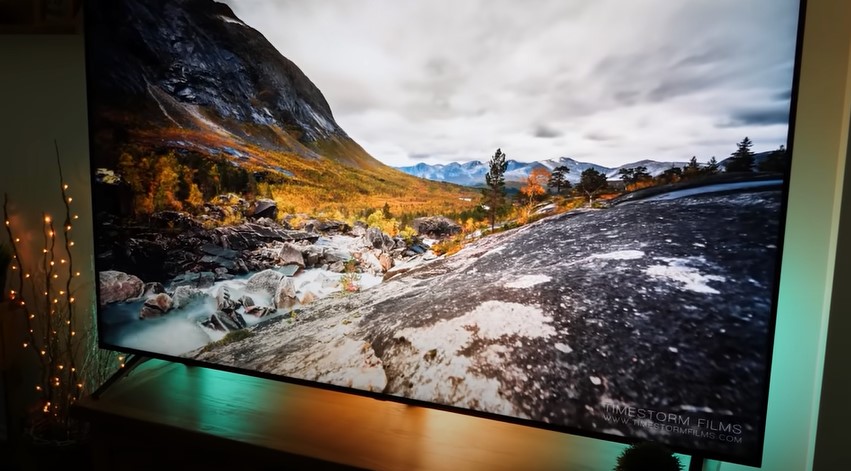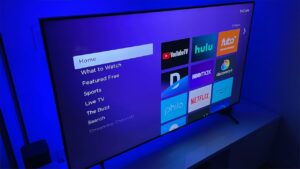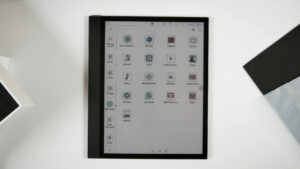If you did not know, LCD stands for liquid-crystal display. When looking into buying one of these TVs whether cheap or expensive you’re going to be looking at two variations of LCD displays. Those two types are In-Plane Switching or IPS and Vertical Alignment or VA. They both come packed with pros and cons so it can be hard to decide on what you should go with.
I’m going to explain a bit about these to better help you with what the best for you.
If you want to know more about LCD TV basics you can go here.
In-Plane Switching
Talking about IPS panels is a little bit like talking about a legend from a long time ago. This is because IPS panels came about to help solve a huge issue that many LCD TVs were struggling with during the 1980s. The biggest issues that were combatted were the poor viewing angle and how the TVs were not able to reproduce colors that our eyes see naturally. This was done through literally rearranging molecules of the liquid crystal between the plates inside the TV.
Some of the techniques created over the years include Horizontal IPS or H-IPS, Enhanced IPS or E-IPS, and Professional IPS or P-IPS. All of these techniques were developed by LG have their own benefits. Such as a better contrast ratio, a better aperture for light transmission, a deeper color gamut and better viewing angles.
Some Manufactures
- LG
- Samsung
- Sony
- Panasonic
- Acer
Positive Effects:
- Accurate color from all viewing angles.
- Little to no “ghosting” or trails from motion heavy scenes.
- Clear and consistent images or scenes.
Vertical Alignment
On the other hand, compared to IPS panels, speaking about VA panels is little like speaking about an up and comer in a wrestling world. They offer tons of options and really great features, but some of their shortcomings may have you rethinking if you prefer them. This is because VA panels do not share the same viewing angle which many people will not prefer.
VA panels achieve their desired effect through ensuring the liquid-crystals are vertically-aligned to the glass panes inside the TVs. The voltage applied and not applied is the biggest factor in how it works. When voltage is applied the crystals begin to tilt. This allows for light to pass through and thus allowing for the shutter-filter combo to do their magic.
When no voltage is applied the liquid-crystals are perpendicular or placed at a right angle adjacent to the glass panes inside the TV. This prevents light from passing through and produces an almost black color reproduction. There are minor leaks of light, but it is minimal.
There are a couple of techniques of VA that work well and offer their own benefits, but for the most part, the benefits remain the same. These techniques are Multi-domain Vertical Alignment (MVA), and Patterned Vertical Alignment (PVA).
Some Manufactures
- LG
- Samsung
- Sony
- Panasonic
- Acer
Positive Effects:
- Better than average viewing angle (poorer than IPS panels though)
- Great contrast ratios
- Strong response time for motion heavy content
- Good color reproduction
- Terrific colors gamuts
Techniques Used in IPS and VA Panels
IPS panels were developed to solve the problem of poor viewing angles and color reproduction that early LCD TVs faced. To address these issues, manufacturers rearranged the molecules of the liquid crystal between the plates inside the TV. Over the years, LG developed several techniques to improve the performance of IPS panels, including Horizontal IPS (H-IPS), Enhanced IPS (E-IPS), and Professional IPS (P-IPS). These techniques offer better contrast ratios, deeper color gamut, better aperture for light transmission, and better viewing angles.
VA panels, on the other hand, achieve their desired effect by ensuring that the liquid crystals are vertically aligned to the glass panes inside the TV. When voltage is applied, the crystals begin to tilt, allowing light to pass through and enabling the shutter-filter combo to do its magic.
When no voltage is applied, the liquid crystals are perpendicular or placed at a right angle adjacent to the glass panes inside the TV, which prevents light from passing through and produces almost black color reproduction. Some of the techniques used in VA panels include Multi-domain Vertical Alignment (MVA) and Patterned Vertical Alignment (PVA).
Manufacturers of IPS and VA Panels
Several manufacturers produce IPS and VA panels, including LG, Samsung, Sony, Panasonic, and Acer. LG is a leading manufacturer of IPS panels, while Samsung, Sony, and Panasonic produce both IPS and VA panels. Acer is known for producing VA panels for gaming monitors.
Advantages of IPS Panels
IPS panels have several advantages, such as:
- Accurate color from all viewing angles: IPS panels offer consistent color reproduction from any viewing angle, making them an ideal choice for those who frequently watch TV with friends and family.
- Little to no “ghosting”: Ghosting or trails from motion-heavy scenes are minimal in IPS panels, ensuring a clear and consistent image.
- Clear and consistent images: IPS panels offer a clear and consistent image, even in fast-paced action scenes or when viewing high-resolution content.
Advantages of VA Panels
VA panels also offer several advantages, including:
- Better than average viewing angle: Although not as good as IPS panels, VA panels offer better viewing angles than traditional LCD panels, ensuring that the picture quality remains consistent, even when viewed from an angle.
- Great contrast ratios: VA panels have excellent contrast ratios, which is essential for displaying deep blacks and vibrant colors.
- Strong response time for motion-heavy content: VA panels are well-suited for displaying fast-moving content, such as sports or action movies, due to their strong response time.
- Good color reproduction: VA panels offer accurate color reproduction, making them a great choice for those who prioritize color accuracy.
- Terrific color gamuts: VA panels offer a wide color gamut, ensuring that colors are bright and vibrant.
Factors to Consider When Choosing a TV Panel
When choosing a TV panel, several factors should be considered, including:
- Viewing angle: If you frequently watch TV with others, an IPS panel may be the better choice, as it offers consistent color reproduction from any viewing angle.
- Contrast ratio: If you prioritize deep blacks and vibrant colors, a VA panel may be the better choice, as it offers excellent contrast ratios.
Another factor to consider is the room lighting. If you plan on watching TV in a bright room with a lot of windows, an IPS panel might be the better option due to its brighter display and better anti-glare coating. However, if you plan on watching TV in a dark room, a VA panel might be the better option due to its deeper blacks and better contrast ratio.
FAQ
1. Are IPS panels better than VA panels?
Both IPS and VA panels have their own advantages and disadvantages. IPS panels offer consistent color reproduction from any viewing angle, while VA panels have excellent contrast ratios and are well-suited for displaying fast-moving content. The choice between the two largely depends on personal preferences and the specific usage scenario.
2. Can I use an IPS panel in a bright room?
Yes, IPS panels are well-suited for bright rooms with a lot of windows because they offer brighter displays and better anti-glare coatings.
3. Can I use a VA panel in a dark room?
Yes, VA panels are ideal for dark rooms because they have deeper blacks and better contrast ratios, which are essential for a clear and vivid picture.
4. What is the best panel type for gaming?
VA panels are often preferred by gamers because they have strong response times and excellent contrast ratios, which are essential for displaying fast-moving content and deep blacks.
5. Can I mount a TV with an IPS panel on the wall?
Yes, TVs with IPS panels can be mounted on the wall just like any other TV.
6. Are IPS panels more expensive than VA panels?
The price of a TV largely depends on the size, features, and brand. However, IPS panels are generally more expensive than VA panels due to their advanced technology and better performance.
7. Do all TV manufacturers offer IPS and VA panels?
No, not all TV manufacturers offer IPS and VA panels. However, many of the leading brands, such as LG, Samsung, Sony, and Panasonic, offer both panel types.
8. Can I calibrate my TV panel for better performance?
Yes, you can calibrate your TV panel to optimize its performance based on your preferences and the specific usage scenario. Many TVs come with built-in calibration tools, or you can use third-party software or hire a professional calibrator.
Conclusion
Depending on the type on a panel a TV, it can have a large effect on the overall picture value a TV can have. There are some clear advantages to one over the other, but be careful as the price of the TV will often mirror more expensive equipment. I hope this helps and have a good day!


